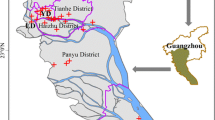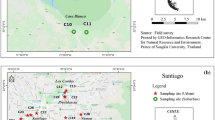Abstract
Residents and advocacy groups began voicing concerns over the environmental quality located in the neighborhoods of Kashmere Gardens, Fifth Ward, and Denver Harbor in Houston, TX, following the confirmation of a cancer cluster in 2019 and another in 2021. These neighborhoods are in close proximity to a railyard and former wood treatment plant known to have utilized coal tar creosote and contain polycyclic aromatic hydrocarbons (PAHs). This research took core soil samples in September and October 2020 from 46 sites to assess for the presence and concentration of the U.S. Environmental Protection Agency’s (USEPA) 7 Carcinogenic PAHs. Results showed the cumulative concentration of these PAHs in each sample was variable with a range of 13,767 ng/g to 328 ng/g and a mean of 2,517.2 ng/g ± 3122. A regional soil screening evaluation revealed that 40 of the 46 soil samples were in excess of the USEPAs most conservative screening levels of 1.0 × 10−6 increased cancer risk, but none exceeding levels considered actionable for remediation. This study is a fundamental first step for quantifying the environmental pollutants in this minority-majority community. Findings revealed a low risk of cancer risk based on current PAH concentrations alone but cannot assess contributions from other contaminants or from past, possibly higher, levels of contamination. Further research is needed to identify the potential casual pathways of the observed cancer cluster and to explore possible remediation needs.



Similar content being viewed by others
Availability of data and material
Data is available for any reasonable request.
Code availability
Not applicable.
References
Agency for Toxic Substances and Disease Registry (ATDSR) AfTSDR. (2002). Toxic Substances Portal-Creosote. https://www.atsdr.cdc.gov/toxfaqs/tf.asp?id=65&tid=18.
Ali, N. (2019). Polycyclic aromatic hydrocarbons (PAHs) in indoor air and dust samples of different Saudi microenvironments; health and carcinogenic risk assessment for the general population. Science of the Total Environment, 696, 133995.
Ammerman, A., Corbie-Smith, G., St George, D., Washington, C., Weathers, B., & Jackson-Christian, B. (2003). Research expectations among African American church leaders in the PRAISE! project: A randomized trial guided by community-based participatory research. American Journal of Public Health, 93, 1720–2172.
Bryant, B., & Mohai, P. (1992). Race and the incidence of environmental hazards. Westeview Press.
Centers for Disease Control and Prevention. (2014). Public health statement for Creosote modified. Accessed 11 Feb 2021, https://wwwn.cdc.gov/TSP/PHS/PHS.aspx?phsid=64&toxid=18.
Chakraborty, J., Collins, T. W., Grineski, S. E., Montgomery, M. C., & Hernandez, M. (2014). Comparing disproportionate exposure to acute and chronic pollution risks: A case study in Houston. Texas Risk Analysis, 34(11), 2005–2020.
Chen, S. C., & Liao, C. M. (2006). Health risk assessment on human exposed to environmental polycyclic aromatic hydrocarbons pollution sources. Science of the Total Environment, 366(1), 112–123.
Chronicle, H. (2001). Harris County wet spots. https://www.chron.com/news/houston-texas/article/Harris-County-wet-spots-2051449.php. Accessed 22 Mar 2021.
CNBC. (2017). Hurricane Harvey rains flood toxic superfund sites in Texas. https://www.cnbc.com/2017/09/03/hurricane-harvey-rains-flood-toxic-superfund-sites-in-texas.html.
Gan, S., Lau, E. V., & Ng, H. K. (2009). Remediation of soils contaminated with polycyclic aromatic hydrocarbons (PAHs). Journal of Hazardous Materials, 172, 532–549.
Horney, J. A., Casillas, G. A., Baker, E., Stone, K. W., Kirsch, K. R., Camargo, K., Wade, T. L., & McDonald, T. J. (2021). Comparing residential contamination in a Houston environmental justice neighborhood before and after Hurricane Harvey”. PLoS ONE, 13(2), e0192660.
Houston Health Department. (2020). Greater fifth ward community assessment. https://www.houstontx.gov/...020-findings-final-01312020.pdf.
Houston Health Department. (n.d.). Fifth ward/Kashmere gardens Union Pacific Railroad site contamination and area Cancer Cluster. https://www.houstontx.gov/health/Environmental/bcceh/fifth-ward-kashmere-gardens-union-pacific-railroad-site-contamination-area-cancer-cluster.html.
Hu, Y., Bai, Z., Zhang, L., Wang, X., Zhang, L., Yu, Q., & Zhu, T. (2007). Health risk assessment for traffic policemen exposed to polycyclic aromatic hydrocarbons (PAHs) in Tianjin China. Science of the Total Environment, 382(2–3), 240–250.
Inam, E., Ibanga, F., & Essien, J. (2016). Bioaccumulation and cancer risk of polycyclic aromatic hydrocarbons in leafy vegetables grown in soils within automobile repair complex and environ in Uyo. Nigeria. Environmental Monitoring and Assessment, 188(12), 1–9.
Kamal, A., Malik, R. N., Martellini, T., & Cincinelli, A. (2014). Cancer risk evaluation of brick kiln workers exposed to dust bound PAHs in Punjab province (Pakistan). Science of the Total Environment, 493, 562–570.
Kaplan, S., & Tabuchi, H. (2017). A sea of health and environmental hazards in Houston’s floodwaters. The New York Times, August 31, 2017, https://www.nytimes.com/2017/08/31/us/Houston-contaminated-floodwaters.html
Li, Q., Kim, M., Liu, Y., & Yoo, C. (2018). Quantitative assessment of human health risks induced by vehicle exhaust polycyclic aromatic hydrocarbons at Zhengzhou via multimedia fugacity models with cancer risk assessment. Science of the Total Environment, 618, 430–438.
Maliszewska-Kordybach, B. (1996). Polycyclic aromatic hydrocarbons in agricultural soils in Poland: Preliminary proposals for criteria to evaluate the level of soil contamination. Appl Geochem., 11(1–2), 121–7.
National Toxicology Program. (NTP). 14th report on carcinogens. Washington: United States Department of Health and Human Services, 2016. Accessed 22 Mar 2021.
Bullard, Robert D. (2000). Dumping in dixie: race, class, and environmental quality (3rd ed.). West View Press.
Sansom, G. T., Kirsch, K. R., Casillas, G. A., Camargo, K., Wade, T. L., Knap, A. H., Baker, E. S., & Horney, J. A. (2021). Spatial distribution of polycyclic aromatic hydrocarbon contaminants after Hurricane Harvey in a Houston neighborhood. Journal of Health and Pollution, 11(29).
Sansom, G. T., Kirsch, K. R., Stone, K. W., McDonald, T. J., & Horney, J. A. (2018). Domestic exposure to polycyclic aromatic hydrocarbons in a houston, Texas. Environmental Justice Neighborhood. Environmental Justice, 11(5), 183–191.
Sexton, K., Linder, S. H., Marko, D., Bethel, H., & Lupo, P. J. (2007). Comparative assessment of air pollution–related health risks in Houston. Environmental Health Perspectives., 115(10), 1388–1393.
Tesi, G. O., Iniaghe, P. O., Lari, B., Obi-Iyeke, G., & Ossai, J. C. (2021). Polycyclic aromatic hydrocarbons (PAHs) in leafy vegetables consumed in southern Nigeria: Concentration, risk assessment and source apportionment. Environmental Monitoring and Assessment, 193(7), 1–15.
Texas Department of State Health Services. (2021). Assessment of the Occurrence of Cancer Supplemental Assessment Houston, Texas 2000–2016.
Texas Department of State Health Services. (2019). Assessment of the Occurence of Cancer Houston, Texas 2000–2016.
U. S. Census Bureau. (2000). American Community Survey, 2011–2015. https://www.census.gov/quickfacts/houstoncitytexas.
United States Environmental Protection Agency (USEPA). (1991). Risk assessment guidance for superfund, 1: human health evaluation manual. Washington, DC: EPA/540 TR-92/003 Publication 9285.7-01B.
United States Environmental Protection Agency. (2002). Guidance on choosing a sampling design for environmental data collection.
United States Environmental Protection Agency. (2002). Five-year review south cavalcade street superfund site Houston, Harris County, Texas. Accessed 5 June 2021. https://semspub.epa.gov/work/06/917454.pdf.
United States Environmental Protection Agency. (2016). Regional screening levels (RSLs)-Equations. Accessed 18 Jan 2022. https://19january2017snapshot.epa.gov/risk/regional-screening-levels-rsls-users-guide-may-2016_.html.
United States Environmental Protection Agency. (2016). Brownfield sites, modified. Accessed 24 Feb 2021. https://archive.epa.gov/pesticides/region4/landrevitalization/web/html/brownfieldsites.html.
United States Environmental Protection Agency. (2022). Regional screening levels for chemical contaminants at superfund sites.
USEPA (United States Environmental Protection Agency). (2009). Risk assessment guidance for superfund. Volume 1: Human Health Evaluation Manual (F, supplemental guidance for Inhalation Risk Assessment) EPA/540/R/070/002, Office of Superfund Remediation and Technology Innovation, Washington, DC.
Walker, G. (2012). Environmental justice: Concepts, evidence and politics. Routledge.
West, R. (1979). Only the strong survive. Texas Monthly, https://www.texasmonthly.com/articles/only-the-strong-survive.
Wickramasinghe, A., Karunaratne, D., & Sivakanesan, R. (2012). PM10-bound polycyclic aromatic hydrocarbons: Biological indicators, lung cancer risk of realistic receptors and ‘source-exposure-effect relationship’under different source scenarios. Chemosphere, 87(11), 1381–1387.
Yang, Y., Woodward, L. A., Li, Q. X., & Wang, J. (2014). Concentrations, source and risk assessment of polycyclic aromatic hydrocarbons in soils from Midway Atoll. North Pacific Ocean. PLoS One., 9(1), e86441.
Zheng, H., Xing, X., Hu, T., Zhang, Y., Zhang, J., Zhu, G., Li, Y., & Qi, S. (2018). Biomass burning contributed most to the human cancer risk exposed to the soil-bound PAHs from Chengdu economic region, Western China. Ecotoxicology and Environmental Safety, 159, 63–70.
Funding
Funding for this study came from the Texas A&M University Superfund Research Center (National Institute of Environmental Health Sciences P42ES027704-01 Center).
Author information
Authors and Affiliations
Contributions
G. Sansom conceptualized and designed the study. GS, LF, and LL collected environmental samples. LF and TM provided laboratory Analysis, WAC provided technical analysis and critical review. All authors contributed to the drafting of the final submitted article and have approved the final article for submission.
Corresponding author
Ethics declarations
Conflict of interest
All authors declare that they have no conflict of interest.
Consent for publication
Not applicable.
Ethical approval
This project and all related materials were approved by the Texas A&M University Institutional Review Board (IRB2020-1064).
Consent to participate
Not applicable.
Additional information
Publisher's Note
Springer Nature remains neutral with regard to jurisdictional claims in published maps and institutional affiliations.
Rights and permissions
About this article
Cite this article
Sansom, G.T., Fawkes, L.S., Thompson, C.M. et al. Cancer risk associated with soil distribution of polycyclic aromatic hydrocarbons within three environmental justice neighborhoods in Houston, Texas. Environ Geochem Health 45, 333–342 (2023). https://doi.org/10.1007/s10653-022-01245-5
Received:
Accepted:
Published:
Issue Date:
DOI: https://doi.org/10.1007/s10653-022-01245-5




